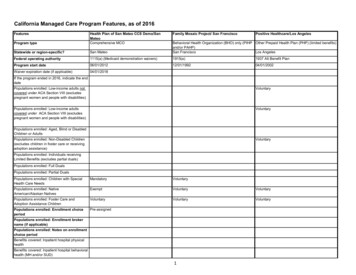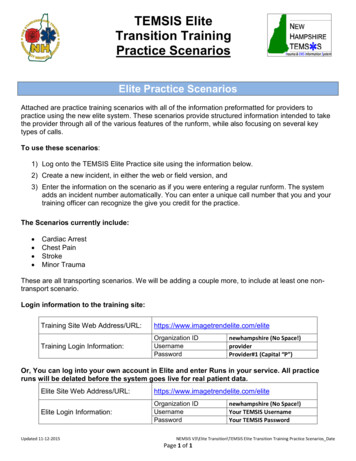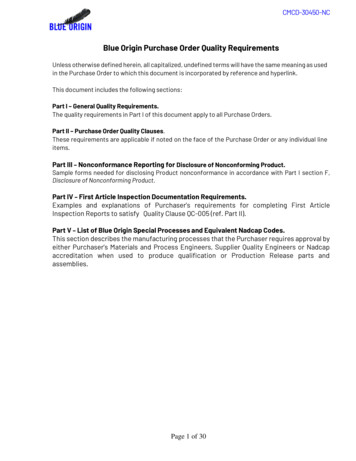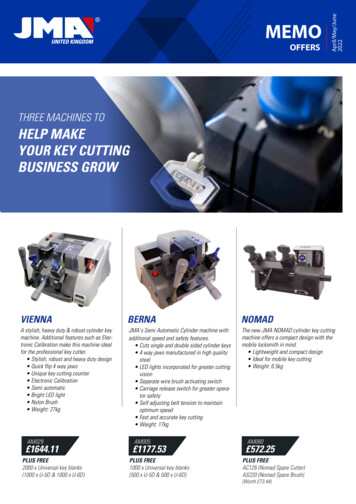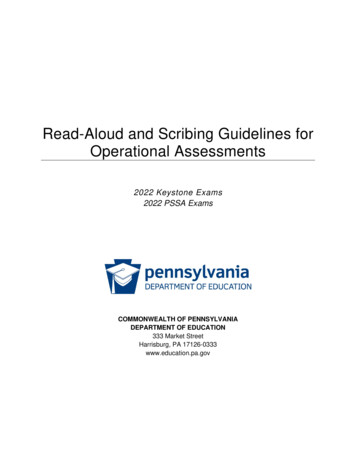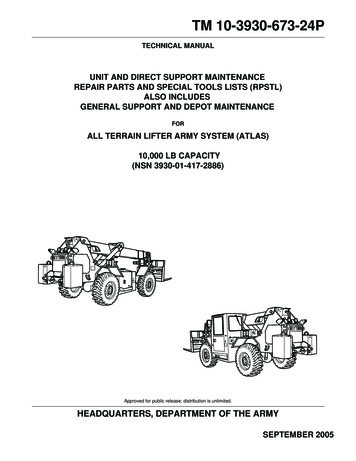
Transcription
UNCLASSIFIED2019 NATIONAL DRUG THREAT ASSESSMENTThis page intentionally left blank.UNCLASSIFIED
PMS 320PMS 505PMS 377UNCLASSIFIEDDRUG ENFORCEMENT ADMINISTRATIONDRUG ENFORCEMENT ADMINISTRATION2019 NATIONAL DRUG THREAT ASSESSMENTThis product was prepared by DEA’s Strategic Intelligence Section.Comments and questions may be addressed to the Office of IntelligencePrograms at DEA.IntelligenceProducts@usdoj.gov. For media/pressinquiries call (202) 307-7977.DFN-701-03--Destroy 2 years after issuance or when the DEA Intelligence Report is supersededor obsolete.UNCLASSIFIED
UNCLASSIFIEDThis page intentionally left blank.UNCLASSIFIED
UNCLASSIFIEDTABLE OF CONTENTS2019 NATIONAL DRUG THREAT ASSESSMENTLetter of Dedication 2Letter from the Acting Administrator 3Executive Summary 4Fentanyl and Other Synthetic Opioids 9Heroin 21Controlled Prescription Drugs 31Methamphetamine 43Cocaine 59Marijuana 77New Psychoactive Substances (NPS) 91Transnational Criminal Organizations 99OCONUS and Tribal Threats 111Illicit Finance 121Gangs 125Appendix A: Additional Figures 141Appendix B: Acronym Glossary 144UNCLASSIFIED
UNCLASSIFIED2019 NATIONAL DRUG THREAT ASSESSMENTLETTER OF DEDICATIONThe 2019 National Drug Threat Assessment (NDTA) is dedicated tothe memory of DEA Supervisory Intelligence Research SpecialistKirsten Walters. Kirsten directly managed the writing, editing,vetting, and release of the NDTA from 2016 through 2019 beforeshe sadly passed away earlier this year. Kirsten’s constant energy,relentless optimism, and calm demeanor in the face of stresswere all key factors in the success of DEA publishing the NDTAevery year. Moreover, her caring disposition, steady guidance,sense of humor, and ever-present smile made Kirsten a wonderfulsupervisor, colleague, mentor, leader, and friend. We miss herdearly and cannot thank her enough for all she has done to enrichboth the DEA as an organization and the lives of all those whowere fortunate enough to know her.2UNCLASSIFIED
UNCLASSIFIEDDRUG ENFORCEMENT ADMINISTRATIONLETTER FROM THEACTING ADMINISTRATORI am proud to present the 2019 National Drug Threat Assessment(NDTA). Produced in partnership with local, state, tribal, andfederal agencies, and integrating the most recently availablereporting from law enforcement, intelligence, and public healthagencies, this annual assessment provides in-depth strategicdrug-related intelligence to inform counterdrug policies,establish priorities, and allocate resources.The global trafficking of illicit drugs poses a grave nationalsecurity threat to our citizens. DEA works closely with all ofour partners around the country and the world to protect ourcommunities from violent criminal organizations and their networks. In every corner ofAmerica and nearly 70 countries overseas, DEA personnel are on the ground workinghand-in- hand with law enforcement and public health officials to combat transnationalorganized crime and serve communities in need.Although the final statistics are still pending, this year we’re hopeful we will see the firstdecrease in drug overdose deaths in 30 years, with the largest decline from controlledprescription drugs. This success is the direct result of the work by DEA and its partnersto reduce opioid quotas, educate the medical community and reduce prescription rates,and to safely and securely remove unwanted and unused controlled substances fromcirculation.I want to thank all of our partners for their contributions to the NDTA, which is among themost important and valuable reports we produce. We at DEA look forward to collaboratingon future initiatives that will help protect our public health and national security interests,at home and abroad.Respectfully,Uttam DhillonActing AdministratorDrug Enforcement AdministrationUNCLASSIFIED3
UNCLASSIFIED2019 NATIONAL DRUG THREAT ASSESSMENTEXECUTIVE SUMMARYThe 2019 National Drug Threat Assessment (NDTA)a is a comprehensive strategic assessment of thethreat posed to the United States by domestic and international drug trafficking and the abuseof both licit and illicit drugs. The report combines federal, state, local, and tribal law enforcementreporting; public health data; open source reporting; and intelligence from other governmentagencies to determine which substances and criminal organizations represent the greatest threat tothe United States.National Drug Threat Assessment Scope and MethodologyThe 2019 NDTA is a comprehensive assessment of the threat posed to theUnited States by the trafficking and abuse of illicit drugs. The report provides strategicanalysis of the domestic drug situation during 2018, based upon the most recentlaw enforcement, intelligence, and public health data available for the period. It alsoconsiders data and information from 2017 and earlier, when appropriate, to provide themost accurate assessment possible to policymakers, law enforcement authorities, andintelligence officials.In preparation of this report, a full year of data is collected for each drug categoryby DEA Intelligence Research Specialists. DEA Intelligence Research Specialistsconsidered quantitative data from various sources (seizures, investigations, arrests,drug purity or potency, and drug prices; law enforcement surveys; laboratory analyses;and interagency production and cultivation estimates) and qualitative information(subjective views of individual agencies on drug availability, information on theinvolvement of organized criminal groups, information on smuggling and transportationtrends, and indicators of changes in smuggling and transportation methods).Illicit drugs, and the transnational and domestic criminal organizations that traffic them, continue torepresent significant threats to public health, law enforcement, and national security in theUnited States. The opioid threat (controlled prescription drugs, synthetic opioids, and heroin)continues at ever-increasing epidemic levels, affecting large portions of the United States. Meanwhile,the stimulant threat (methamphetamine and cocaine) is worsening and becoming more widespreadas traffickers continue to sell increasing amounts outside of each drugs’ traditional markets. Newpsychoactive substances (NPS) remain challenging and the domestic marijuana situation is evolvingas state-level medical and recreational legalization continues. Drug poisoning deaths are theleading cause of injury death in the United States. In 2017b, drug poisoning deaths reached theira. Analyst Note: The information in this report is current as of August 2019.b. Analyst Note: 2017 overdose-related death statistics is the latest available official data.4UNCLASSIFIED
UNCLASSIFIEDDRUG ENFORCEMENT ADMINISTRATIONhighest recorded level and, every year since 2011, have outnumbered deaths by firearms, motorvehicle crashes, suicide, and homicide. In 2017, approximately 192 people died every day from drugpoisoning (see Appendix A: Figure A2).Fentanylc and Other Synthetic Opioidsd: Fentanyl and other highly potent synthetic opioids—primarily sourced from China and Mexico—continue to be the most lethal category of illicit substancesmisused in the United States. Fentanyl continues to be sold as counterfeit prescriptions pills astraffickers—wittingly or unwittingly—are increasingly selling fentanyl to users both alone and as anadulterant, leading to rising fentanyl-involved deaths. Fentanyl suppliers will continue to experimentwith other new synthetic opioids in an attempt to circumvent new regulations imposed by theUnited States and China.Heroin: Heroin-related overdose deaths remain at high levels in the United States, due to continueduse and availability, while fentanyl is increasingly prevalent in highly profitable white powder heroinmarkets. Mexico remains the primary source of heroin available in the United States according to allavailable sources of intelligence, including law enforcement investigations and scientific data. Further,high-levels of sustained opium poppy cultivation and heroin production in Mexico allow MexicanTransnational Criminal Organizations (TCOs) to continue to supply high-purity, low-cost heroin.Controlled Prescription Drugs (CPDs): CPDs are still responsible for the most drug-involvedoverdose deaths and are the second most commonly abused substances in the United States.Traffickers continue to manufacture and distribute counterfeit CPDs often-containing fentanyl andother opioids along with non-opioid illicit drugs in attempts to expand their customer base andincrease profits. Overall diversion incidents continue to decline; however, CPDs lost in transit ordiverted by medical professionals remains a prevalent threat across the United States.Methamphetamine: Methamphetamine remains widely available, with traffickers attempting tocreate new customers by expanding into new, non-traditional methamphetamine markets such as theNortheast, or other user bases with new product forms. Most of the methamphetamine available inthe United States is produced in Mexico and smuggled across the Southwest Border (SWB). Domesticproduction occurs at much lower levels than in Mexico and seizures of domestic methamphetaminelaboratories have declined steadily for many years while overall supply has increased.Cocaine: Cocaine is a resurgent threat in the United States as domestic indicators—such asseizures, availability, and overdose deaths—remain at elevated levels. Cocaine-involved overdosec. Unless explicitly stated, the term “fentanyl,” when used in this report, refers to clandestinely manufactured and illegally distributed fentanyl and not topharmaceutical or “licit” fentanyl.d. In this document, the phrase “synthetic opioid” refers to only those substances, which are classified as opioids and have no plant-based material intheir production (i.e. fentanyl, fentanyl-related substances, and other novel opioids) and therefore does not include heroin.UNCLASSIFIED5
UNCLASSIFIED2019 NATIONAL DRUG THREAT ASSESSMENTdeaths continue to exceed established benchmarks, primarily due to the continued spread of fentanylinto the cocaine supply. In addition, coca cultivation and cocaine production in Colombia, the primarysource of supply for cocaine in the United States, remain at high levels.Marijuana: Marijuana remains the most commonly used illicit drug in the United States. The natureof the marijuana threat continues to evolve, as more states vote on referendums and initiatives aswell as pass legislation regarding the possession, use, and cultivation of marijuana. Most states thathave legalized marijuana have placed no limits on Tetrahydrocannabinol (THC) potency of marijuanaor its associated concentrate products. Consequently, THC potency continues to increase, as doesdemand. Mexico remains the most significant foreign source for marijuana available in theUnited States, but domestic marijuana production and availability continues to rise. Black marketmarijuana production by local, national, and transnational criminal trafficking organizations continuesto increase, predominantly in states that have legalized marijuana.New Psychoactive Substances (NPS): The number of NPS varieties continues to increaseworldwide, but remains a limited threat in the United States compared to other widely available illicitdrugs. China remains the primary source for the synthetic cannabinoids and synthetic cathinonestrafficked into the United States. The availability, popularity, and the public health threat of specificNPS varieties in the United States changes every year, as traffickers experiment to circumvent legalrestrictions and discover more potent, and therefore popular, substances.Mexican TCOs: Mexican TCOs remain the greatest criminal drug threat to the United States; noother groups are currently positioned to challenge them. The Sinaloa Cartel maintains the mostexpansive footprint in the United States, while the Jalisco New Generation Cartel (Cartel Jalisco NuevaGeneración or CJNG) has become the second-most dominant domestic presence over the past fewyears. Although drug-related murders in Mexico continue to reach epidemic proportions, U.S.-basedMexican TCO members still generally refrain from domestic inter-cartel conflicts, resulting in minimalspillover violence in the United States.Colombian TCOs: Colombian TCOs’ control over the production and supply of cocaine to MexicanTCOs allows Colombian TCOs to maintain an indirect influence on U.S. drug markets. Meanwhile, ongoing disputes between the Government of Colombia and the remnants of the Revolutionary ArmedForces of Colombia (FARC) and other Armed Criminal Groups continue to, at times, exacerbate theproblem of sustained high-levels of illicit coca cultivation in Colombia. Smaller Colombian TCOs stilldirectly supply wholesale quantities of cocaine and heroin to Northeast and East Coast drug markets.Dominican TCOs: Dominican TCOs dominate the mid-level distribution of cocaine and white powderheroin in major drug markets throughout the Northeast while also engaging in some street-level salesin the region. Dominican TCOs work in collaboration with foreign suppliers to ship cocaine and heroindirectly to the United States from Mexico, Colombia, and the Dominican Republic. Family members6UNCLASSIFIED
UNCLASSIFIEDDRUG ENFORCEMENT ADMINISTRATIONand friends of Dominican nationality or American citizens of Dominican descent comprise themajority of Dominican TCOs, insulating them from outside threats.Asian TCOs: Due to China’s currency control restrictionse, Asian TCOs have taken advantage ofthe availability of U.S. dollars belonging to Mexican and Colombian TCOs in the United States byacquiring the U.S. dollars in exchange for the payment of Colombian/Mexican pesos in the respectivedrug source country. TCOs launder drug proceeds through a variety of means, the primary being ahybrid of trade-based money laundering (TBML) and the black market peso exchange (BMPE). AsianTCOs continue to operate indoor marijuana grow houses in states with legal personal-use or medicalmarijuana laws. Asian TCOs also remain the primary 3,4-Methylenedioxymethamphetamine (MDMA)source of supply in U.S. markets, trafficking MDMA from China or clandestine laboratories in Canadainto the United States.Outside Continental United States (OCONUS) and Tribal Threats: Cocaine is the principaldrug threat in the Caribbean followed by marijuana, with Puerto Rico and the U.S. Virgin Islands(USVI) serving as major transshipment points for both drugs. Methamphetamine and marijuanaremain the top two drugs of choice in Guam, with cocaine being a rising threat as an alternative tomethamphetamine due to changing prices. The drug threat in Indian Country varies by region and isinfluenced by the illicit drugs available in major cities near the reservations. Methamphetamine andmarijuana remain the most widely abused substances in Indian Country.Illicit Finance: U.S. drug sales continue to account for tens of billions of dollars in illicit proceedsannually. These proceeds change hands multiple times across various levels of the illegal drugmarket. Bulk cash smuggling seizure amounts remain at lower levels than in previous years,indicating that TCOs may be employing different methods of moving monetary value through thefinancial system. While traditional methods of laundering money are still the most widely used, theadvent of 21st century methods may increase the complexity of anti-money laundering enforcementactivities in the future.Gangs: National and neighborhood-based street gangs and prison gangs remain the dominantdistributors of illicit drugs through street-sales in their respective territories throughout the country.Struggle for control of lucrative drug trafficking territories continues to fuel the majority of the streetgang violence facing local communities. Meanwhile, some street gangs are working with rival gangsto increase both gangs’ drug revenues, while individual members of assorted street gangs haveprofited by forming relationships with friends and family associated with Mexican cartels.e. China currently has a 50,000 annual foreign exchange limit for its citizens.UNCLASSIFIED7
UNCLASSIFIED2019 NATIONAL DRUG THREAT ASSESSMENTThis page intentionally left blank.8UNCLASSIFIED
UNCLASSIFIEDFENTANYL ANDOTHER SYNTHETIC OPIOIDSOverviewFentanyl remains the primary driver behindthe ongoing opioid crisis, with fentanyl involvedin more deaths than any other illicit drug.Fentanyl and other synthetic opioids are widelyavailable throughout the Great Lakes, Midwest,and the Northeast areas of the United States.The two primary sources of the fentanyl areMexico and China, where drug traffickersproduce fentanyl and other synthetic opioids inclandestine operations. Fentanyl is smuggledinto the United States across the SWB as wellas through international mail and expressconsignment shipping services, primarily inpowder and counterfeit pill form, indicatingclandestinely produced fentanyl as opposed topharmaceutical fentanyl. Increases in fentanylcontaining counterfeit pills and related fentanylpill pressing operations in addition to other novelpreparations demonstrate traffickers’ continuedefforts to expand the fentanyl user base.AvailabilityFentanyl availability was high and increasingacross the majority of the United States in2018, highlighting the rapid spread of the drug.For Calendar Year (CY) 2018, 15 of 23 FieldDivisions (FDs) (see Appendix A: Figure A1)(65 percent) indicated fentanyl availability was“high” and 21 of 23 FDs (91 percent) indicatedfentanyl was “more” available compared to2017 (see Figure 1). The Caribbean, Dallas,Denver, Houston, New Jersey, Omaha, and SanFrancisco FDs did not rank fentanyl as highlyFigure 1. Field Division Reporting of FentanylAvailability in CY 2018 and Comparisonto CY 2017AvailabilityDuringAvailabilityCompared toAtlanta Field DivisionCaribbean Field DivisionChicago Field DivisionDallas Field DivisionDenver Field Detroit Field DivisionEl Paso Field DivisionHouston Field DivisionHighHighModerateStableMoreMoreLos Angeles Field DivisionLouisville Field DivisionMiami Field DivisionHighHighHighMoreStableMoreNew England Field DivisionNew Jersey Field DivisionNew Orleans Field DivisionHighModerateStableMoreMoreMoreNew York Field DivisionOmaha Field DivisionPhiladelphia Field DivisionPhoenix Field DivisionSan Diego Field DivisionSan Francisco FieldDivisionSeattle Field DivisionSt. Louis Field DivisionWashington Field reModerateMoreHighHighHighMoreMoreMoreField DivisionCY 2018CY 2017Source: DEAavailable. This illustrates that, although fentanylis trafficked across the SWB and is commonlyseized in the Southwestern United States, theMidwest, Great Lakes, and Northeast regionsmaintain the greatest availabilities of fentanyl.The total number of fentanyl reports submittedto forensic laboratories continues to increaseUNCLASSIFIED9
UNCLASSIFIED2019 NATIONAL DRUG THREAT ASSESSMENTFentanyl and Other Synthetic OpioidsFigure 2. Forensic Laboratory Reports of Fentanyl, 2005 – 2017Source: DEAsignificantly, demonstrating the availabilityof fentanyl in the United States (see Figure2). In 2017, there were 56,530 fentanylreports submitted to the National ForensicLaboratory Information System (NFLIS), whichis a 65 percent increase over the 34,204reports submitted in 2016. Of the top 25most frequently identified drugs in NFLIS,fentanyl ranked fifth overall and represented3.57 percent of the top 25 drug reports. Forcomparison, there were 157,055 reports ofheroin, which represented 9.93 percent of thetop 25 drug reports.Therefore, whileFigure 3. State-level Fentanyl Reports, 2017fentanyl availabilitycontinues to increase,heroin maintains asignificant presence inthe U.S. drug market.State-level reportsin NFLIS continueto show fentanyl’sdominant presence inthe Great Lakes andNortheast regions ofthe United States with alessor presence in theWestern United States.Ohio, Pennsylvania,Massachusetts, New10Source: DEAUNCLASSIFIED
UNCLASSIFIEDDRUG ENFORCEMENT ADMINISTRATIONFigure 4. Nationwide Reports of Fentanyl, Synthetic Opioids, and Precursor Chemicals, 2017Fentanyl and Other Synthetic OpioidsSource: DEAYork, and New Jersey had the most fentanylreports in NFLIS in 2017 (see Figure 3).Moreover, Ohio, Pennsylvania, and New Jerseywere among the five states with the mostheroin reports in NFLIS in 2017. This furtheremphasizes the continued overlap between theheroin market and the fentanyl market.Overlap between the fentanyl market and thecocaine market appears to remain limited evenas law enforcement across the country reportmore instances of the two drugs mixed. Twoof the states with the most fentanyl reportsin NFLIS in 2017—Ohio and New York—alsooverlapped with states that submitted the mostcocaine reports, with Ohio overlapping betweenfentanyl, heroin, and cocaine. This may bedue to a combination of the overall increasedavailability of cocaine in the United States andthe significant co-occurrence of cocaine andfentanyl in overdose deaths.Fentanyl represented nearly three-quarters ofall state reports of fentanyl, synthetic opioids,and precursor chemicals to NFLIS in 2017,showing continued higher availability of thedrug compared to other synthetic opioids(see Figure 4). Carfentanil was the secondmost reported synthetic opioid overtakingfuranyl fentanyl (third), suggesting carfentanilavailability increased between 2016 and 2017.Carfentanil’s availability is largely driven byOhio’s submissions, which reported 77 percentof all state-level reports of carfentanil in 2017.According to DEA’s Fentanyl Signature ProfilingProgram (FSPP), fentanyl seized and analyzed inthe United States in 2018 averaged 5.3 percentpure, based on analysis of approximately 722fentanyl powder exhibits representing 929kilograms. FSPP analysis indicated fentanylavailable in the United States could range from0.1 percent to 96.8 percent pure depending onUNCLASSIFIED11
UNCLASSIFIED2019 NATIONAL DRUG THREAT ASSESSMENTFentanyl and Other Synthetic OpioidsFigure 5. Fentanyl Combination Reports, 2014 – 2017Source: DEADEA’s Fentanyl Signature ProfilingProgramThe FSPP performs in-depth chemical analyseson fentanyl and fentanyl-related exhibitsobtained from seizures made throughoutthe United States. Analytical methodologiesdeveloped at the Special Testing and ResearchLaboratory (STRL) give in-depth reporting onseizures and link seizures for intelligencepurposes. FSPP data is not intended to reflectU.S. market share but, rather, is a snapshot ofsamples submitted to STRL from DEA regionallaboratories.A new methodology recently developed by DEAresearchers can now routinely identify thefentanyl synthetic route ( 65 percent of currentsamples). The previous methodology couldonly determine the route in approximately onepercent of samples examined.12the source of the fentanyl. DEA and Customsand Border Protection (CBP) reporting indicatesthe fentanyl shipped directly from China istypically seized in smaller quantities withpurities commonly testing above 90 percent.By comparison, fentanyl trafficked overlandinto the United States from Mexico is typicallyseized in larger, bulk quantities with much lowerpurity, with exhibits on average testing at lessthan ten percent pure. DEA’s FSPP reportedwholesale (typically 1 kg) fentanyl/heroinseizures accounted for approximately 16 percentby weight of the powders examined. Across allexhibits, fentanyl was mixed with heroin in 32percent of the exhibits examined; indicating drugtrafficking organizations (DTOs) at the regionaland retail levels inside the United States areprimarily responsible for the mixing of heroin andfentanyl rather than TCOs in Mexico.According to NFLIS data, in 2017, fentanyl wasmost commonly observed as the only controlledsubstance in fentanyl exhibits tested by forensicUNCLASSIFIED
UNCLASSIFIEDDRUG ENFORCEMENT ADMINISTRATIONFentanyl Resembling Black Tar Heroin Identified in Tucsonthere have been seizures of fentanyl mixedwith black tar heroin, this is the first knownsubmission to the Tucson PD Crime Laboratory offentanyl made to resemble black tar heroin. Forcontext, in CY 2018, out of 1,283 total fentanylexhibits, STRL analyzed 14 exhibits of “black tar”fentanyl. Of those, five contained heroin.laboratories across the country, continuingthe trend of the past several years. Fentanylwith heroin was the most commonly observedmixture, with over nine times as many fentanyland heroin mixtures identified as fentanyl andcocaine mixtures (see Figure 5). Between 2016and 2017, the number of reports of fentanyland heroin increased 97 percent; the numberof reports of fentanyl and cocaine increased 74percent; and the number of reports of fentanylwith methamphetamine increased 173 percent.Fentanyl and Other Synthetic OpioidsIn August 2018, Tucson Police Department (PD) officers arrested an individual in possession oftwo individually wrapped bindles, one containing .75 grams of methamphetamine and the othercontaining .52 grams of a dark tar-like substance with a vinegar odor. The Arizona High IntensityDrug Trafficking Area (HIDTA) Counter Narcotics Alliance Task Force submitted both substancesto the Tucson PD Crime Laboratory for analysisFigure 6. Fentanyl Resembling Blackand identified that the black tar substance wasTar Heroinfentanyl, most likely mixed with sugar. AlthoughSource: Arizona High Intensity Drug Trafficking AreaUseFentanyl use remains high in the United Statesand is a major contributor to the ongoingepidemic of drug overdose deaths. The highpotency and powerful effects of fentanylcontinue to cause users to overdose and die inrecord high numbers. The Centers for DiseaseControl and Prevention (CDC) reported a 47percent increase in synthetic opioid-involveddeaths from 19,413 deaths in 2016 to 28,466deaths in 2017. Synthetic opioids were presentin more drug-involved overdose deaths thanany other illicit drug for the second consecutiveyear. While other substances, such as tramadol,are included in the synthetic opioid category,fentanyl is chiefly responsible for the syntheticopioid-involved deaths reported in this category.Fentanyl-involved overdose deaths continue tobe highest in the Great Lakes, Midwest, andNortheast regions of the United States (seeFigure 7). In 2017, West Virginia, Ohio, NewHampshire, Maryland, and MassachusettsUNCLASSIFIED13
UNCLASSIFIED2019 NATIONAL DRUG THREAT ASSESSMENTFentanyl and Other Synthetic OpioidsFigure 7. Synthetic Opioid-involved Deaths by State, Age-Adjusted Rate, 2017Source: Centers for Disease Control and Preventionhad the highest age-adjusted rates of fentanylinvolved overdose deaths.Fentanyl-containing counterfeit pills continue tobe associated with overdose deaths across thecountry. Fentanyl traffickers use fentanyl powderand pill presses to produce pills that resemblepopular prescription opioids, such as oxycodoneand hydrocodone, and other popular prescriptiondrugs, such as alprazolam. According to researchfrom The Partnership for Safe Medicines (PSM),as of January 2019, 46 statesf had encounteredfentanyl-containing counterfeit pills since2015. PSM reported that fentanyl-containingcounterfeit pills were responsible for overdosedeaths in at least 29g of those states. In manycases, the colorings, markings, and shape of thecounterfeit CPDs were consistent with authenticprescription medications, meaning users mightnot be able to differentiate fentanyl-containingpills from authentic prescription medications. In February 2019, Tucson, AZ Police responded toreports of multiple individuals overdosing at a partyafter taking fentanyl-containing counterfeit oxycodonepills. Police administered naloxone to the individuals,with treatment saving three people but coming too latefor one person who died. Investigators believe the fourthought they were taking authentic oxycodone andwere unprepared for a dose of fentanyl. In March 2019, public safety officials in Minnesota saidfentanyl pills disguised as oxycodone have appearedand may have caused the death of someone in thestate. According to the Blue Earth County Sheriff’sf. According to PSM, the only states with no confirmed presence of fentanyl-containing counterfeit pills were Delaware, Hawaii, Kansas, and Nebraska.g. According to PSM, states with confirmed fatalities because of fentanyl-containing counterfeit pills were as follows: Arizona, California, Colorado,Connecticut, Florida, Georgia, Idaho, Illinois, Indiana, Iowa, Kentucky, Maryland, Mississippi, Montana, Nevada, New Hampshire, New Mexico, NewYork, North Carolina, Ohio, Oklahoma, Oregon, Pennsylvania, South Carolina, Tennessee, Texas, Utah, Virginia, and Washington.14UNCLASSIFIED
UNCLASSIFIEDDRUG ENFORCEMENT ADMINISTRATIONOffice, the decedent was found with blue “M30”pills, which investigators believe originated from drugtraffickers in Mexico.In addition, in 2018, FSPP reported an increasein tablets containing acetaminophen anddipyrone, substances typically observed inMexico-sourced heroin. To date, 85 exhibits(59 percent) contained a combination ofacetaminophen and dipyrone as the primarydiluents compared to only 17 percent of exhibitscontaining these substances in 2017. All of thesetablets contained fentanyl HCl at an averagedose of 1.6 milligrams per tablet with a range offentanyl concentration from 0.5 to 2.3 milligramsper tablet. The consistency in the scientificprofile of these counterfeit pills as well as theinclusion of substances commonly associatedwith Mexico-sourced heroin both indicate thisparticular “brand” of counterfeit tablet is likelyproduced by Mexican TCOs.Illicit fentanyl production requires no plantmaterial; rather, it is synthesized in laboratoriesentirely from chemicals, unlike heroin. Thefentanyl available in the United States isprimarily sourced to either China or Mexico;however, there are new source and transitcountries emerging as important players in t
diverted by medical professionals remains a prevalent threat across the United States. Methamphetamine: Methamphetamine remains widely available, with traffickers attempting to create new customers by expanding into new, non-traditional methamphetamine markets such as the Northeast, or other user bases with new product forms.

